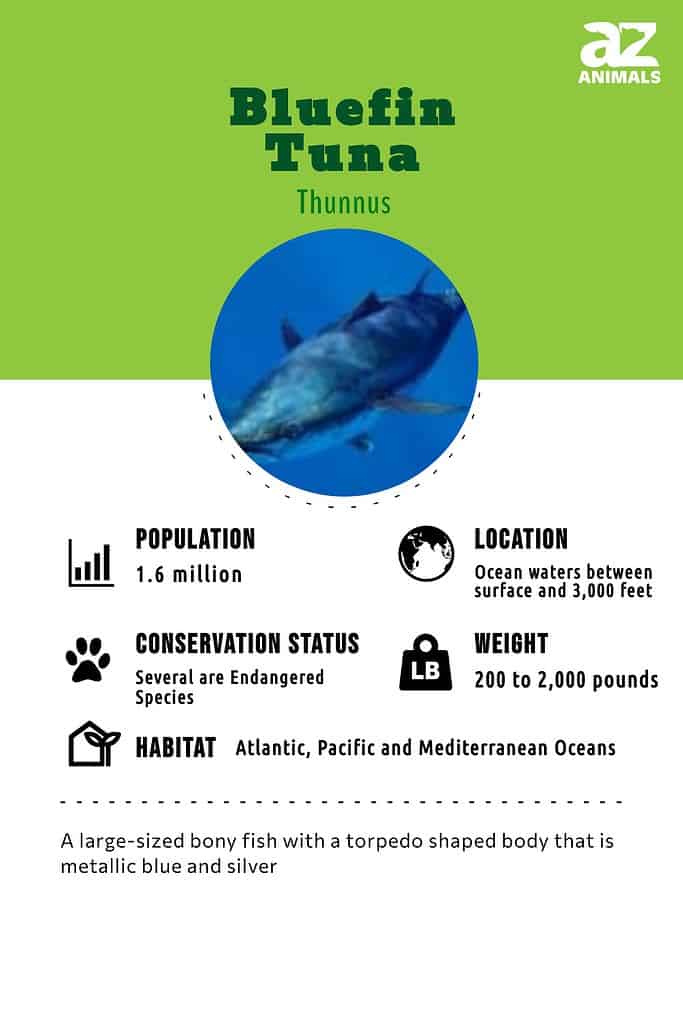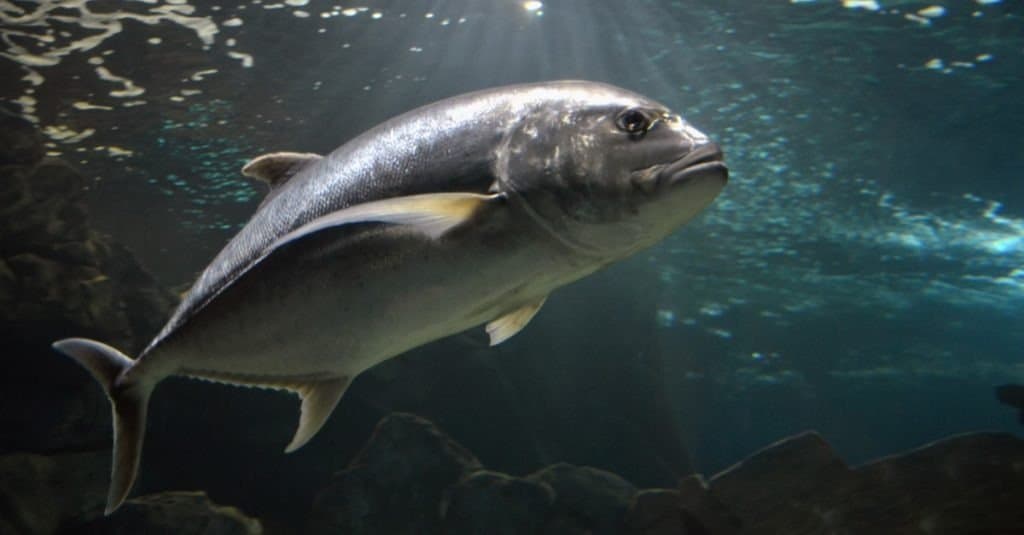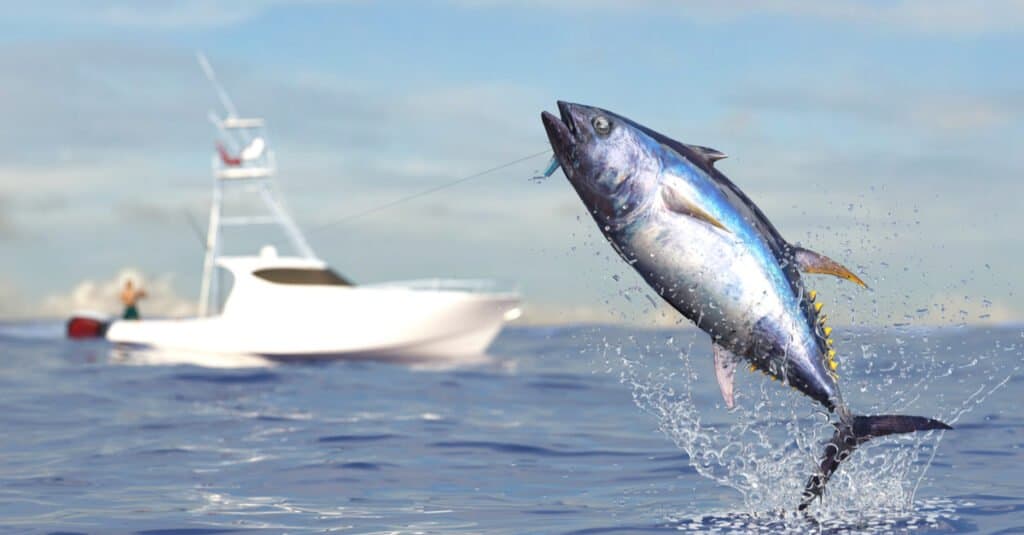Bluefin Tuna
The bluefin is one of the largest fish in the world
Advertisement
Bluefin Tuna Scientific Classification
Read our Complete Guide to Classification of Animals.
Bluefin Tuna Conservation Status
Bluefin Tuna Facts
- Main Prey
- Fish, crustaceans, cephalopods, and mollusks
- Group Behavior
- School
- Fun Fact
- The bluefin is one of the largest fish in the world
- Estimated Population Size
- More than a million
- Biggest Threat
- Overfishing
- Most Distinctive Feature
- The torpedo-shaped body
- Other Name(s)
- Giant bluefin
- Gestation Period
- A few days
- Habitat
- Oceans
- Diet
- Carnivore
- Type
- Ray-finned fish
- Common Name
- Bluefin tuna
- Number Of Species
- 3
View all of the Bluefin Tuna images!
The bluefin is the largest and most prized of all the tuna species.
There are five true bluefin species: the Pacific bluefin, Atlantic bluefin, Albacore bluefin, Southern bluefin, and Bigeye bluefin. The yellowfin tuna was recently separated into subspecies.

3 Incredible Bluefin Tuna Facts!
- Bluefin tuna fish can dive deeper than 3,000 feet.
- The bluefin tuna fish has excellent vision, perhaps the best of any bony fish.
- The bluefin tuna fish migrates vast distances every year in large schools.
Classification and Scientific Name
The bluefin tunas go by the scientific name of Thunnus.
Bluefin tuna, or Thunnus thynnus, is a species of large fish in the family Scombridae. They are native to both the Atlantic and Pacific oceans, as well as the Mediterranean Sea. Bluefin tuna has two main subspecies: Northern Bluefin Tuna (Thunnus thynnus thynnus) and Southern Bluefin Tuna (Thunnus maccoyii). Both can be found throughout their respective ocean basins, with some overlap between them.
The bluefin tuna belongs to the order Perciformes, which includes many other bony fishes such as perch-like fish, basses, and breams. It also belongs to the class Osteichthyes — otherwise known as ray-finned fishes — which make up around 96% of all living fish species.
This species has an impressive body shape that’s divided into two parts; its front half is deep-bodied and curved, while its back half is slender and tapered for speed during swimming. Its scales are small compared to other types of tunas, but it does have several easily visible finlets located along each side of its body behind the dorsal fin itself. It also features sharp teeth in both jaws that help it capture prey such as squid and small pelagic fish like herring or mackerels when hunting in open water habitats like near-shore reefs or offshore banks.
Evolution

Bluefin tuna have evolved over millions of years.
©iStock.com/T-Fujishima
Bluefin tuna is an important species of fish that has been around for millions of years. It is believed to have evolved from the ancestral Thunnus obesus, which existed in the Miocene period about 15 million years ago. This ancestor was a large and powerful predecessor to the modern-day bluefin tuna, with a much larger body size than today’s species.
Over time, due to environmental changes and competition, this ancient species shrank in size until it became what it is today – a smaller but more streamlined predator adapted to survive in its current environment. The modern-day bluefin tuna can be found throughout all oceans around the world, living at depths ranging from surface waters down to over 1,800 feet deep. When hunting, they are known to dive up to 3,000 feet. They are highly migratory creatures that travel long distances each year between their spawning grounds and feeding areas, giving them access to the nutrients and resources they need for survival.
Appearance

©lunamarina/Shutterstock.com
Bluefin tuna are large, sleek fish with bright metallic blue coloring on their back and sides. Their bellies are white or silver in color, and they have long pectoral fins that give them a streamlined appearance when swimming. They can grow up to ten feet in length and weigh over 1,000 pounds! Bluefin tuna also have two dorsal fins located near the tail end of the body. Their heads are pointed and sharp, with small eyes set close together above their mouth, which contains long, thin teeth designed for grasping prey.
Distribution, Population, and Habitat

Atlantic bluefin tuna are endangered species.
©jurgal photographer/Shutterstock.com
The Pacific and Atlantic bluefin are only found in the northern parts of their respective oceans, while the southern bluefin is endemic to the oceans of the Southern Hemisphere.
Due to overfishing, many bluefin stocks are in peril. The Pacific bluefin is vulnerable, the Atlantic bluefin is endangered, and the southern bluefin is critically endangered. Learn more about the most endangered species on the planet here.
Predators and Threats
Bluefin tuna are apex predators, meaning they have few natural predators that can hunt them. Their main predators are other large fish, such as sharks and billfish. They also face threats from human activities such as overfishing, illegal fishing, pollution, and habitat destruction. These threats have caused the population of bluefin tuna to decline drastically in recent years. Conservation efforts are being made to protect the species, but there is still a long way to go before their numbers recover to healthy levels.
Diet

Bluefin tuna Thunnus thynnus saltwater fish in the Mediterranean Ocean
©iStock.com/LUNAMARINA
The bluefin tuna is an apex predator and opportunistic feeder. They hunt by sight and scent to find food, primarily by locating small schools of fish such as herring, anchovies, mackerels, sardines, squid, eels, or other small fishes. They also eat crustaceans such as crabs and shrimp. Bluefin tunas have been known to consume other marine mammals, including dolphins and porpoises in some cases. The diet of the bluefin tuna can vary depending on its size and location. They may switch prey based on availability or seasonally migrate in search of a more abundant food source. In addition to their natural diet of fish and invertebrates, commercial fisheries often use baitfish to attract them for capture, which can lead them toward areas with a higher concentration of these baits, like certain ports or harbors that are commonly used for fishing activities.
Reproduction and Lifespan

Bluefin Tuna are often killed accidentally as bycatch of commercial fishing.
©iStock.com/DeepAqua
Bluefin tuna reproduce by spawning, which is a process of releasing eggs and sperm into the water. The female can release up to 10 million eggs in a single spawn. Spawning usually occurs between June and September when temperatures are at their highest. After mating, the fertilized eggs drift with ocean currents until they hatch 4-7 days later, depending on temperature and salinity levels. Upon hatching, larvae measure just 1–2 mm in length before growing quickly over time. As juveniles grow, they move to different areas for shelter from predators. Young bluefin tuna tend to congregate near floating objects such as buoys or seaweed patches for protection from predators like dolphins and sharks. Bluefin tuna have an average lifespan of 15 years, but some can live much longer. One specimen was estimated to be 50 years old!
Fishing and Cooking
The three species of bluefin together only account for 1% of total tuna stocks. However, the high-quality meat of the bluefin is considered to be a delicacy in many cuisines, especially sushi, and sashimi. The fatty otoro meat is taken from the stomach near the head, while the leaner chutoro comes from the middle or back stomach.
5 Types of Bluefin Tuna

Bluefin tuna and yellowfin tuna have been separated into different taxonomy groups
©Al McGlashan/Shutterstock.com
It was once believed that there were seven varieties of the true tuna species included in the genus Thunnus. However, research in 1999 concluded that Atlantic and Pacific bluefin tuna were separate species. Additionally, within the genus Thunnus, two subgenera have been identified: Thunnus (Thunnus), which are the bluefin group, and Thunnus (Neothunnus), which comprises the yellowfin group.
Bluefin Genus Thunnus:
- Albacore Tuna – Thunnus alalunga
- Southern Bluefin Tuna – Thunnusmaccoyii
- Bigeye Tuna – Thunnus obesus
- Pacific Bluefin Tuna – Thunnus orientalis
- Atlantic bluefin Tuna – Thunnus thynnus
Yellowfin subGenus Neothunnus:
- Yellowfin Tuna – Thunnus albacares
- Blackfin Tuna – Thunnus altalnticus
- Longtail Tuna – Thunnus tonggol
Conservation

Humans are the largest threats to the bluefin tunas survival
©bekirevren/Shutterstock.com
The conservation status of bluefin tuna can vary depending on the species. The Southern Bluefin Tuna (SBT) is currently listed as “Critically Endangered” by the International Union for Conservation of Nature (IUCN). The Pacific Bluefin Tuna (PBT) and Atlantic Bluefin Tuna (ABT) are both classified as “Endangered,” also according to IUCN standards.
Humans are the biggest threat to bluefin tuna survival due to overfishing and unsustainable fishing practices. Climate change and ocean acidification have an effect on their habitat, making it difficult for them to find food sources or reproduce successfully in some areas. There has been a decrease in available spawning grounds, leading to further declines in population numbers. In addition, illegal commercial fishing continues unchecked across many regions of the world’s oceans, depleting stocks of this valuable resource at an alarming rate.
Conservation efforts must be put into place quickly if we want any chance of recovering these magnificent creatures before they become extinct from our waters forever. Governments around the world need to cooperate with each other and pass legislation that sets limits on fishing quotas while enforcing strict regulations against illegal activities such as pirate fishing or finning sharks for their fins only. Additionally, marine protected areas could provide safe havens which allow fish populations time to recover without interference from human activity
View all 285 animals that start with BBluefin Tuna FAQs (Frequently Asked Questions)
Why is bluefin so expensive?
Both overfishing and the decline of bluefin stocks have driven up prices. The flesh of the bluefin is also quite desirable.
Is catching bluefin illegal?
In the US it does require an NOAA permit to catch or import the bluefin. Illegal fishing is a persistent challenge for replenishing stocks.
Is bluefin good to eat?
The bluefin is nutritious and well-regarded for its meat. However, due to its long lifespan, high mercury levels do accumulate in its flesh, so it should be consumed infrequently.
What do bluefin eat?
Bluefin consumes shellfish, squid, and other fish.
Where are bluefin found?
Bluefin is found all over the Atlantic, Pacific, and Indian Oceans.
How many Bluefin Tunas are left in the world?
There are more than a million Bluefin Tunas.
What is an interesting fact about the Bluefin Tuna?
The bluefin is one of the largest fish in the world.
How fast is a Bluefin Tuna?
A Bluefin Tuna can travel at speeds of up to 50 miles per hour.
How do Bluefin Tunas have babies?
Bluefin Tunas lay eggs.
What are the differences between Bluefin tuna and Yellowfin tuna?
The main differences between bluefin and yellowfin tuna are that bluefin is significantly larger, fetch a higher price, and have a smaller global distribution than yellowfin.
Both bluefin and yellowfin tuna are top predators in the world’s oceans, but there are some definitive differences between them. Worldwide, there are three recognized bluefin species, and only one recognized yellowfin species. All three bluefin species are highly prized as sport and culinary fish, but the yellowfin is also seeing an increase in both markets as well. These large, powerful fish are easily identifiable and are clear apex predators in any habitat they frequent.
What are the differences between Bluefin tuna and Bigeye tuna?
The main differences between bluefin tuna and bigeye tuna include their size, appearance, location and water depth.
What are the main differences between Ahi Tuna and Bluefin Tuna?
Ahi tuna and the bluefin tuna differ in size, appearance, pectoral fins, and water depths.
Thank you for reading! Have some feedback for us? Contact the AZ Animals editorial team.
Sources
- WWF, Available here: https://www.worldwildlife.org/species/bluefin-tuna
- National Geographic, Available here: https://www.nationalgeographic.com/news/2014/2/140220-tuna-guide-skipjack-yellowfin-albacore-bluefin-bigeye-sushi/

















